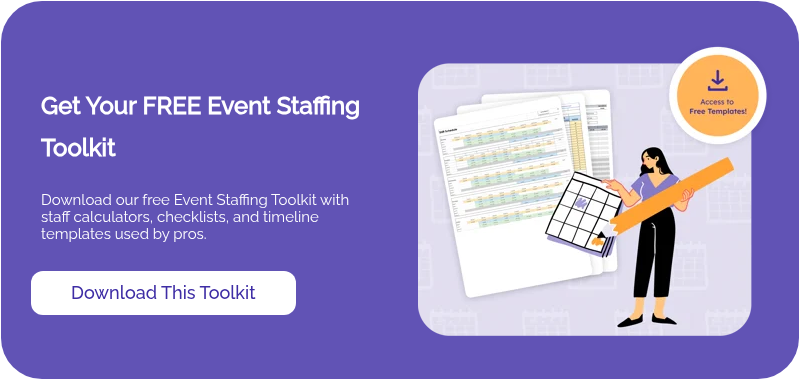Planning events can be both exciting and daunting.
As an event planner, you might pour your heart and soul into creating memorable experiences for your clients and guests. But have you ever stopped to think about the bigger picture of event planning?
The event industry is constantly evolving, with new trends shaping the way we approach event planning, marketing, and management.
Today, we're focusing on some eye-opening statistics reflecting industry evolution and trends for 2024.
Key Takeaways
- The events market is set to reach $538.6 billion by 2030, signalling expansive opportunities. With a growing demand for unique experiences, event planners can capitalize on emerging trends and innovative approaches for profitability.
- A noticeable shift to in-person events highlights the enduring value of face-to-face interactions. Event planners prioritize venues and activities facilitating personal connections, recognizing their pivotal role in creating impactful experiences.
- Despite industry growth, event planners grapple with persistent attendance challenges due to market saturation and shifting behaviors. Creative strategies, targeted marketing, and enhanced engagement are crucial to attract and retain participants.
- Event planners maintain positivity despite challenges, citing industry resilience and adaptability. Confidence in the sector's ability to innovate is promising for continued growth and success in the future.
1. Events Market Is Expected to Reach More than $500 Billion by 2030
The U.S. events market demonstrated remarkable growth in 2020, attaining a valuation of $94.8 billion. Projections indicate a substantial escalation as the market is forecasted to soar to $538.6 billion by 2030, representing an impressive Compound Annual Growth Rate (CAGR) of 13.0% from 2021 to 2030.
This upward trend underscores the industry's resilience and potential for expansion, signaling lucrative opportunities for stakeholders across the board. As the market continues to evolve, fueled by innovation and changing consumer preferences, it reaffirms the pivotal role of events in driving economic vitality and cultural enrichment on a national scale.
2. 70% of Events Are Being Conducted in Person as Opposed to Virtually
As the world emerges from the shadows of the pandemic, a notable shift is observed in event formats, with approximately 70% of events reverting to in-person gatherings compared to their virtual counterparts.
This transition marks a significant milestone in the recovery journey, reflecting a collective desire to build connections that transcend digital interfaces. Businesses, in particular, are leading this change, recognizing the irreplaceable value of face-to-face interactions in cultivating relationships, driving engagement, and fostering meaningful experiences.
Although virtual events were pivotal during times of uncertainty, their significance continues to endure. Rather than becoming obsolete, they offer a complementary solution, allowing companies to integrate hybrid formats that broaden their reach across global audiences. This adaptability not only enhances accessibility but also amplifies engagement, offering attendees diverse options to participate and connect.
3. There’s Been a Nearly 80% Increased Adoption of Technology in the Event Planning Industry
The event planning landscape is witnessing a remarkable shift, with 78% of event planners embracing technology to a greater extent than before the COVID-19 era. This surge in tech adoption is driven by multifaceted motivations, ranging from cost containment to enhancing ROI (Return on Investment), addressing staffing challenges, optimizing system workflows, and continuously monitoring attendee interests across the event lifecycle.
As event professionals navigate the complexities of post-pandemic planning, technology emerges as a critical ally, empowering them to navigate challenges effectively while unlocking new opportunities for innovation and success. This increased reliance on technology underscores a fundamental transformation in the industry's approach, heralding a future where digital solutions play an integral role in shaping seamless, impactful event experiences.
4. Nearly 75% of Millennials Prioritize Experiences Over Material Possessions
In today's consumer landscape, millennials’ preferences are reshaping the event industry, with a staggering 70% of this demographic prioritizing experiences over material possessions. This cultural shift towards experiential consumption has fueled the rapid growth of experiential events as millennials seek out unique and memorable experiences that resonate on a deeper level.
This trend is not only driving demand for immersive and interactive event formats but also challenging event planners to innovate and create engaging experiences that capture the imagination of this influential demographic.
As millennials continue to assert their influence, experiential events are poised to remain a dominant force in the industry, shaping the future of event planning and consumption patterns alike.
5. The Event Industry Generates More Than 1 Million Jobs in the United States
The event industry's substantial contribution to job creation is a testament to its economic significance. Annually, in the United States alone, this vibrant sector generates over 1.3 million jobs, spanning various roles and skill sets.
From event planners and technicians to caterers and venue staff, these positions form a vital part of the workforce, driving economic growth and providing livelihoods for many. Beyond the numbers, these jobs contribute to the fabric of communities, nurturing creativity, innovation, and collaboration. As the industry continues to evolve and adapt to changing trends and technologies, its role in job creation remains a cornerstone of its impact on the national economy.
6. Over 50% of Event Planners Struggle to Increase Event Attendance
Event planning isn’t always easy. 52% of event planners say their biggest challenge is getting more people to attend their events. This difficulty can stem from various factors, such as competing events saturating the market, limited resources for marketing and promotion efforts, or shifting consumer behaviors and preferences.
These complexities underscore the importance of creativity and strategic thinking in devising effective methods to attract more attendees to events. It's all about understanding what's important and finding ways to make it happen. With this insight, event planners can navigate challenges effectively and unlock the full potential of their endeavors.
7. There Were Almost 45,000 Trade Show and Conference Planning Companies in the US in 2023
As of 2023, the United States is home to 44,327 trade show and conference planning businesses, a notable increase of 3.8% from the previous year. This growth reflects the industry's strength and ongoing demand for expert event planning services.
From coast to coast, there is a considerable market for even planning services, showcasing a diverse range of expertise and specialization within the field. With such a substantial number of businesses, competition within the industry is fierce, driving companies to continually innovate and improve their services to stay competitive.
Notably, California emerges as the epicenter of this thriving industry, boasting the highest concentration of trade show and conference planning businesses, totaling 1,286 establishments. Following closely behind are Florida, with 677 businesses, and New York, with 576, further emphasizing the geographical diversity and widespread demand for expert event planning services across the nation.
8. 85% of Event Planners Are Optimistic About Their Job Security
Amidst the rapidly evolving landscape of event planning, a substantial 85% of professionals express optimism regarding their job security, signalling confidence in the industry's trajectory. Furthermore, a significant proportion affirms their passion for their roles, demonstrating unwavering dedication despite challenges.
With the disappearance of COVID-19 restrictions and the waning impact of the pandemic, the event job market is projected to expand by 11%, potentially reaching a staggering 5.9 million jobs. These statistics not only underscore the enduring allure of pursuing a career in event planning but also highlight the industry's capacity for renewal and adaptation in a post-pandemic era.
The Promising Outlook for the Future of Event Planning
Looking ahead to the future of event planning and the rebirth of the event industry, it's clear that the sector exhibits resilience and adaptability.
Despite global economic challenges impacting the industry, event planners maintain a hopeful outlook. This optimism stems from the ability to innovate and evolve, finding creative solutions to overcome obstacles and meet changing demands. This collective optimism suggests that the industry is on the right path, and event planners are confident about their prospects.\
Workstaff: An Event Staffing App That Simplifies Workforce Management
The pandemic's impact on the event sector has spurred increased reliance on technological solutions, such as event staffing apps, enabling event digitization, organization, and communication.
Workstaff, a widely used platform in the event industry, streamlines shift scheduling, personnel planning, and team communication. Through its mobile app, managers can easily track worker availability, make bookings, and post job offers, ensuring seamless communication via instant messaging.
Frequently Asked Questions
How has the event industry responded to recent global challenges and evolved over time?
The event industry adapted to global challenges by embracing technology, hybrid event formats, and innovative strategies to include more attendees.
How is technology being integrated into modern event management practices?
Technology enhances event planning through streamlined processes, data analytics, virtual experiences, and attendee engagement tools.
Why do millennials prioritize experiences over material possessions, and what impact does this have on events?
Millennials value experiences for deeper connections, impacting event demand towards immersive, interactive formats.
What are the primary challenges event planners face in increasing event attendance?
Challenges in boosting attendance include competition, marketing limitations, and shifting consumer behaviors.
How does the geographical distribution of event planning businesses across the US reflect industry demand and trends?
The geographical distribution of event planning businesses across the US reflects varying levels of industry demand and trends. Concentrations in certain regions suggest areas of high event activity and economic significance.











